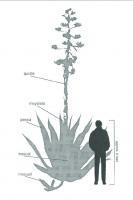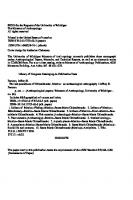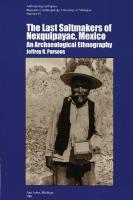Maguey Utilization in Highland Central Mexico: An Archaeological Ethnography 9780915703203, 9781949098907
The maguey plant plays a central role in cultural adaptation and cultural change in highland Mesoamerica. This book is a
208 16 15MB
English Pages [407] Year 1990
Contents
List of Tables
List of Figures
List of Plates
Acknowledgments
Chapter 1. Introduction
General Considerations
The Study Area
The Community of Orizabita
Organization of This Monograph
Chapter 2. The Cultivation of Maguey and the Production of Pulque
Synopsis of the Process
Transplanting the Young Maguey Plant
Care of the Growing Plant
Capazon (Castration) and Picazon (Picking)
The Raspada (Collecting and Transporting Aguamiel)
Fermenting the Aguamiel
The JG Tinacal, Orizabita
The LC Tinacal, Orizabita
The BH Tinacal, Tecomatlan
The HT Tinacal, near Itzcuinquitlapilco
The HP Tinacal, Emiliano Zapata
The MP Tinacal, Itzcuinquitlapilco
The TL Tinacal, Singuelucan
The RT Tinacal, Jalapillo
Summary
Miscellaneous Operations
Chapter 3. Processing and Spinning Fiber
Maguey Fiber Extraction
Spinning Maguey Fiber
Lechuguilla Fiber Extraction
Making Rope from Lechuguilla Fiber
Chapter 4. Archaeological Implications
Introduction
The Sixteenth-Century Production Process
The Tool Kits and Workshops
The Production and Distribution of Maguey Products
Chapter 5. Summary and Conclusions
Bibliography
Glossary
Appendix. Analysis of a Midden Sample from the LR Maguey Fiber Processing Workshop, by Sandra L. Dunavan
Introduction
Methods
Results
Recommend Papers

File loading please wait...
Citation preview
$:l)
"'0 "'0
o>
:l..
~
~
~ ~
"-
~
~
>:l..
;l
>:l
;l
c·
....
>:l
~.
E...
...
C"':l
~
~
~
~
Maguey Utilization in Highland Central Mexico
92
90
80
70
60
50 :>
~ .....
::t:
\? O· ;:l S·
~.
~ §: .....
~
~
~
CAl
Expected Archaeological Tool
One or more large ceramic jars for water storage. One or more small ceramic bowls for pouring water. One or more large ceramic basins for washing. Large ceramic basin, possibly with encrustation of maize-dough solution on interior walls
Wooden mallet, with large pounding stone for support
Iron scraper and wooden scraping board
Small plastic or tin can for pouring water. Large plastic or metal containers for storing dail y needs.
Large basin, with soap-lime solution
Pounding maguey leaf
Scraping maguey leaf
Providing water for rotting pit, washing, and scraping
Bleaching scraped fiber
Trapezoidal basalt tool ("azada"), with smoothly ground working edge. "Scraper-plane"(?)
Large pounding stone. Stone hammer(?) "Scraper-plane"(?)
Obsidian blade or flake knife. Small prismatic blades may be suitable.
Iron knife
Large obsidian blade or flake knife, with sharp, or serrated edges. Analagous to "agave knife" in the North American Southwest.
Trimming spines or fibers
Modem Tool
Iron cutting blade
Cutting maguey leaf from plant
Activity
TABLE 19 Expected Tools and Implements at an Archaeological Maguey Fiber Workshop
"'-l
w o
~
o·
>:l ....
C:;.
~....
.......
"-
>:l
1=;'
>:l
~
S.
308
Maguey Utilization in Highland Central Mexico
source of short, coarse fibers for prehispanic populations in central Mexico, and it is therefore appropriate to consider what implications our observations might have for archaeological purposes. Some of our general discussion in the last part of the section on maguey fiber processing (see above) is relevant at this point, and the reader is referred back to this material for some relevant general perspectives that will not be repeated here. The remainder of this section will focus exclusively on the very specific archaeological implications of our observations of lechuguilla fiber processing in 1983 and 1984. In a context of prehispanic transportation (that is, where transport is restricted to human carriers) it is uncertain whether or not purely wild lechuguilla stands could have sustained permanent fiber-processing workshops. The typical lechuguilla workshops in Orizabita are small, temporary operations that seldom function for more than a few months before they exhaust the lechuguilla within easy walking distance. The larger and more permanent workshop at the RF residence (RF W orkshop A) appears to be closely dependent upon modern mechanized transport. The present system (at least before pickup trucks were common) seems to demand an extensive adaptation in which small, temporary workshops are established at a number of loci throughout the source area, leaving behind a steadily accumulating number of abandoned sitting stones and pounding stones, but very little else of any enduring character. On the other hand, there are also clear suggestions that a more intensive pattern could have existed, or once did exist. We have referred to ethnographic reports from the 1930s of a cultivated variant of lechuguilla (Mendizabal 1947) and the transplantation of wild plants in the 1980s (Rangel 1987; Salinas and Bernard 1983). These techniques could have greatly increased lechuguilla productivity well beyond its present-day level. Furthermore, it would appear that even the average modern wild density of 21,000 lechuguilla plants per hectare (Gentry 1982:157) might be able to sustain permanent small workshops of a size comparable to our RF Workshop A. If each average lechuguilla plant contains ten usable pencas (a conservative estimate), then an average hectare should yield 210,000 pencas every harvest season. If our RF Workshop A operates three hundred days per year, and processes a thousand pencas per day, then its annual requirement would be 300,000 pencas. In this case, less than two hectares of wild lechuguilla plants could easily supply the annual needs of such a workshop. If we assume that it takes five years for a harvested area to naturally recover its full growth of wild plants, it should still be possible for a single permanent workshop of this size to be supplied in perpetuity from an area of four or five hectares. Substantially larger workshops, of course,
Archaeological Implications
309
could easily be supplied from areas of ten to twenty hectares. Such areas, if not too widely dispersed, could be easily accessible for human carners. We will not attempt to deal systematically here with the precise reasons why the organization of modern lechuguilla fiber processing in Orizabita does not seem to conform more closely to the theoretical possibilities for permanent workshops. This is obviously a complex issue, relating to questions of environmental quality, the decline of the fiber industry, competition from other forms of land use, land tenure, and perhaps even individual psychology. Mendizabal (1947:177), for example, notes that within the Mezquital region, lechuguilla is significantly more abundant in the relatively wet Zimapan area (located about 25 km northwest of Orizabita) than in the drier region around Ixmiquilpan. At this point we are content to note that the modern pattern of small, temporary workshops need not necessarily be the only way that lechuguilla could have been exploited, either earlier in the historic period or in prehispanic times. Large, permanent workshops are theoretically feasible, and there is good reason to suspect significantly greater intensity of lechuguilla fiber production prior to the 1940s. It is unlikely, however, that lechuguilla fiber-extraction workshops would ever have been located very far from the source of their raw material. It is true that, relative to maguey, the lechuguilla penca contains a far higher proportion of fiber (II percent compared with 2 or 3 percent, Tables 13, 14, 15) and its scraped pulp (shite) is useful. Nevertheless, there is still a high proportion of waste material involved, and the overall value of the products is comparatively low. Because lechuguilla pencas contain less waste, it is likely that efficient use of lechuguilla can include more transport than can maguey, but probably not very much more. Exactly how much transport distance might be feasible for unscraped lechuguilla pencas is an open and interesting question. We wonder, for example, how feasible it might have been for complex prehispanic systems to produce and collect lechuguilla pencas in the arid Mezquital and carry them 50 to 100 km southward into much more densely populated areas for processing and consumption. Reconstructing a prehispanic tool kit for lechuguilla fiber processing is difficult because many tasks that we now observe are dependent upon the use of a metal scraping bar. Many of the points we raised earlier about the stone cutting and scraping tools that may have been associated with maguey fiber processing are probably relevant here: that is, we expect heavy, smooth-sided tools of fine-grained basalt for scraping; large, serrated knives of obsidian or basalt for cutting leaves off plants; and some form of heating or rotting facilities used to loosen the flesh from the fibers prior to scraping. Since the short, coarse lechuguilla
310
Maguey Utilization in Highland Central Mexico
fibers are likely to have been destined for mundane, utilitarian purposes, such as the manufacture of sandals and rope, it is likely that there would have been less concern with such procedures as cleaning and bleaching the fibers. These processes played a rather prominent role in the technology of maguey fiber production because finer textiles can be produced from the longer, finer maguey fiber. At lechuguilla fiber workshops we might expect to find fewer large basins for washing and bleaching. With respect to the matter of associated waste products and their disposal, lechuguilla fiber workshops would appear to be less productive than maguey fiber workshops of large quantities of spines, thorns, and cut-off butt ends. Compared with maguey pencas, lechuguilla leaves are smaller, have less waste, and have less formidable thorns and spines. On the other hand, we also saw that lechuguilla thorns and spines are more likely to be detached in the workshop than in the source area; the reverse is more common for maguey pencas. Although sizable quantities of thorns and spines seem to build up in lechuguilla workshops, only in permanent workshops are such materials systematically swept up and discarded in a manner that might permit them to enter the archaeological record. Archaeologically, then, we might expect to find charred fragments of lechuguilla thorns and spines in a large midden. Lechuguilla spines are quite different in form and size from those of the larger maguey (Plates 164, 165), and the two species should be easily distinguished on this basis. In Orizabita lechuguilla leaves are not presently heated or rotted prior to scraping. However, Pennington (1963:202) reports that among the Tarahumara of Chihuahua, pounded lechuguilla leaves are boiled or baked in a pit prior to being scraped with an iron knife or "sharp stone. " We expect that similar preparations would also have been part of any significant prehispanic use of lechuguilla, since it is so much more difficult to scrape with wood or stone tools unless the flesh is softened beforehand. Consequently, roasting pits, large hearths, and washing basins are expected features of prehispanic lechuguilla fiber processing. As in the case of maguey fiber processing, it is interesting to consider the organizational implications of the optimal number of people that might be involved in a lechuguilla fiber workshop. The principal tasks performed in connection with fiber processing at the RF workshop are: (1) cutting the leaves in the source area, (2) transporting the leaves to the workshop, (3) trimming the spines from the leaves, (4) pounding and scraping the leaves, and (5) drying the scraped fiber and pulp. Ideally the most efficient production could be achieved in a situation where all these operations could occur simultaneously. At RF Workshop A only steps (3) and (4) are fully simultaneous, and the others are performed
A rchaeologicall mplications
311
cm .......6t-~.....
Plate 163. Modern circular iron maguey scraper and two archaeological obsidian discoidal scrapers, top views.
more or less sequentially. At RF Workshop B the whole operaton is essentially sequential. The greatest increase in efficiency would occur if one or two additional people were involved full-time in the collection and transportation of the lechuguilla pencas. In the modern context of comparatively weak demand and low economic returns, full efficiency is obviously not a top priority in the production of lechuguilla fiber. Nevertheless, the whole operation is considerably more efficient than the production of maguey fiber, particularly relative to the small-scale penca cruda maguey fiber workshop we described earlier. We suspect that a minimum of three or four full-time laborers are necessary to operate a viable lechuguilla workshop. With six to ten people a much more efficient operation should be fea ible. A labor force of this size would be consistent with a large nuclear family or extended family; lechuguilla fiber production has traditionally been organized in this fashion among ethnographic groups in the Mezquital (Lanks 1938; MendizabaI1947). Significantly larger workshop organizations would certainly be feasible, and probably necessary, where larger and more efficient production were necessary or desirable. It is also
312
Maguey Utilization in Highland Central Mexico
Plate 164. Sample of maguey spiny waste .
likely that significantly larger workshop operations might require significant changes in the organization of the production, distribution, and access to raw materials.
Spinning Maguey Fiber Locational Considerations Earlier in this chapter we argued that, primarily because of the very high proportion of waste material in the heavy maguey leaves (up to 98 percent by weight), maguey fiber would necessarily have been extracted in localities close to where the maguey plant was cultivated. However, once the fiber has been extracted and dried, it is quite light and durable, and could have been much more readily transported to distant workshops for spinning and weaving. Thus, there is no reason to expect that spinning and weaving would necessarily have been carried out close to where maguey was cultivated. A great variety of arrangements would have been feasible: spinning and weaving may have been done
Archaeological Implications
313
/
Plate 165. Sample of lechuguilla spiny debri .
either in local households or in larger workshops in maguey-producing areas, but some (even most) may well have occurred at some considerable distance from where the maguey plants were grown and the fiber extracted. The latter situation, of course, would probably be most expected in the context of hierarchically organized systems with effective redistributional networks on a fairly large scale. The high concentrations of maguey spindle whorls in some Postclassic urban centers in the Valley of Mexico (e.g., Brumfiel 1976; T. Charlton and D. Nichols, personal communication) and at Tula (e.g., R. Diehl, personal communication; Healan 1977:147) suggest distant urban workshops. Once the maguey fiber is at hand, pinning and weaving are particularly well adapted to small-scale, individualized production. In the context of a drop-spinning and belt-loom technology, one spinner is just as effective as many in transforming fiber into thread and cloth, and there would seem to be little or no productive advantage to large-scale spinning or weaving workshops. Thus, maguey fiber spinning seems particularly suited to "cottage industry" production by persons who are concomitantly immersed in a domestic economy. The widespread dispersal
314
Maguey Utilization in Highland Central Mexico
of archaeological maguey spindle whorls at rural Postclassic sites in central Mexico suggests such a pattern (e.g., M. Parsons 1972). A cottage industry mode of production would also have been well suited to a complementary seasonal division of labor in which stored maguey fiber was spun and woven during the long winter agricultural off-season for seed crops in the tierra jr{a. Carrasco (1976:224-26) has noted the distinction at the time of European contact between the spinning and weaving services performed as tribute by virtually all commoner women in Highland Central Mexico, and the more specialized production of high quality cloth by women who worked at the rulers' palaces. This suggests that spinning and weaving were widespread in both rural and urban settings throughout Highland Central Mexico, although it is still quite difficult to distinguish between cotton and maguey cloth production in the documentary sources. The Relationship Between Spindle Whorl Weight and Thread Thickness Our studies focused on what size range (as measured by weight) of spindle whorls could be used to spin the finest two- and three-strand maguey fiber threads. Our informants in Orizabita used some of their own spindle whorls, but our most useful information came when we asked them to spin different threads with our own sample of fourteen different, fully intact archaeological spindle whorls that we had purposefully selected to cover a wide weight range (from 6.7 to 74.8 g). Although we asked our informants to spin with the heavier whorls (50.0 to 74.8 g), we did not try to determine the exact thread-size ranges they could spin with the large whorls once we had established that these heavier whorls could not be used to produce the fine two- or threestrand thread that most interested us. We also wanted to see if maguey fiber could be spun on what we had earlier thought were cotton whorls (M. Parsons 1972). Basically, we wanted to determine how experienced ixtle spinners would manage spindle whorls of very different sizes. Each of our four informants in Orizabita owned between two and five spindle whorls. These whorls ranged in weight between 16.2 and 45.2 g (Fig. 39; Plates 166, 167); two of the whorls (E-1 and G-1 *) are ceramic disks, recently made from potsherds; one whorl (G-2)* is a small piece of hard rubber that was once a tire on a child's toy truck. The remaining whorls used by our informants are prehispanic ceramic specimens. These latter whorls are highly prized, and most of them had been acquired as chance finds or as bequests from relatives; one woman says she purchased hers some years ago at the Ixmiquilpan market. 'Not illustrated in Figure 39.
315
Archaeological Implications
w
0)
C0 CD ® \1D CD CU7 C) 00 \JD 00 CD C) ~j
,,
, , '-'
C i! J ' ,
,,
,,
,'
'-'
!
l
!:
(-)
,,' ,,
::
()
,: I:
(... ..'
\~)
®
CD
®
CD
~-)
,--
,,
em
,,' ,,
C~ C/ '
'-'
,
,, ,,
Figure 39, Cross-sections and plans of spindle whorls in use at Orizabita.
Most of the prehispanic whorls used by our informants have been in the same families for generations, handed down from mother to daughter over a long (but unknown) period. We never saw any spindle whorls for sale, and nobody we talked to had any clear idea about where well-made new whorls might be obtained. Clearly, few if any spindle whorls are now being manufactured, apart from a few ad hoc specimens (such as the sherd disks and toy truck wheel noted above). For thirteen whorls from the 1984 sample of informants' whorls we prepared a scatter plot showing the relationship between whorl weight and thread thickness, as measured by number of fiber strands (Fig. 40).
316
Maguey Utilization in Highland Central Mexico 22 20 18 16 III
""C C
1~
0
.... iii ""C
12
0
10
.;:: I-
8
(l) ....
6




![Origins of Agriculture in Western Central Asia : An Environmental-Archaeological Study [1 ed.]
9781934536513, 9781934536162](https://ebin.pub/img/200x200/origins-of-agriculture-in-western-central-asia-an-environmental-archaeological-study-1nbsped-9781934536513-9781934536162.jpg)




